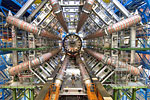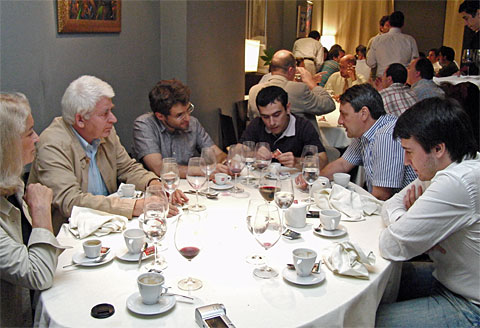



The Large Hadron Collider (LHC), located in the border area between Switzerland and France, took nearly 20 years to complete and cost six billion Swiss francs (3.76 billion Euros or 5.46 billion dollars) is one of the costliest and most complex scientific experiments ever attempted. The machine uses over 1,600 superconducting magnets, cooled by 96 tons of liquid helium, to accelerate beams of protons in opposite directions in a circular tunnel with a circumference of 27 kilometres (17 miles). The protons achieve about 99.999999% of the speed of light, then smash into each other with a collision energy of 14 TeV (trillions of electron volts).

At 13:06h Central European Summer Time the LHC achieved its first record-breaking collisions: with both beams up and running at 3.5 TeV – several times any previous collision energies achieved – the proton streams were carefully moved to cross in the detector arrays. Physicists in the control room of CERN broke into applause when the human race's first 7 TeV collisions appeared on the monitors (above, below).

Scientists all over the world joined in the celebration. Typical were the Skype messages we received from a friendly physicist Vera Spillner: "It's working, first collisions! – I am SO excited!! – I can see first results and they are UNKNOWN events!!!!! – I have never seen such events before: two muons recorded, and not coming from a J/psi decay!! This is historic! I am almost crying." Now you know what really turns on pretty young girls today.

The above image, supplied by Taylor Childers, a colleague of Vera at LHC, shows particle tracks in the inner detector of the ATLAS experiment, recorded within the first running hour of the LHC beam at 7 TeV.
Large Hadron Collider – how it works
The problem discussed by a number of grandmasters was the following: experts have expressed concerns over the safety of the LHC, since the collider experiments have the potential to create low velocity micro black holes that could grow in mass, leading to doomsday scenarios, such as the destruction of the Earth. There are many web sites dedicated to this possibility, and you can google them with LHC + black holes. An extreme view on the subject is shown in the video below:
Vivid video footage of the doomsday scenario
 Magnus Carlsen contemplating the future of the world after the LHC is switched on
Magnus Carlsen contemplating the future of the world after the LHC is switched on

Participants in a round table discussion on potential dangers emanating from the Hadron Collider: Marina and Boris Spassky, Armenian GMs Levon Aronian and Gabriel Sargissian, Boris Radjabov, GM Teimour Radjabov.

Teimour Radjabov was quite concerned with the implications of the LHC experiment

Physicist Vera Spillner explaining collisions and black holes to Aruna and Vishy Anand...

...during a Champions' Dinner at the Mainz Chess Classic
Vera told Anand and his wife that there are very good arguments for the safety of the LHC experiments. Micro black holes may indeed be generated, but if they are they will be very hot and soon evaporate due to Hawking radiation. "Very hot" in the language of physicists is 10^50 degrees (ten with 50 zeros tagged on) and "soon" is one octillionth of a nanosecond. In addition Vera sought to allay their fears by reminding them that hundreds of micro black holes are produced every day by high energy cosmic particles colliding with protons of our atmosphere. "If the man-made mini black holes are the same as the cosmic-made ones, then what's the probability that the few extra black holes produced in colliders will eat up everything, whereas the trillions of holes produced since the formation of our planet didn't?" Finally she reminded us that cosmic rays from the universe have been creating micro black holes on the surface of white dwarf and neutron stars for billions of years, and would be captured by the density of these bodies. The fact that we still observe white dwarfs and neutron stars means that this did not happen, the micro black holes evaporated. Everyone slept a little quieter that night.
 Cuban GM Leinier Dominguez with his girlfriend Yisel Martinez
Cuban GM Leinier Dominguez with his girlfriend Yisel Martinez
Our first conversation with this remarkable young lady ran as follows: "So where are you from, Yisel?" – "Cuba. Actually from the same village as Leinier." – "And what do you do? What is your profession?" – "I am an atomic physicist." – "You are a WHAT?" – "You know: atom? Boom!" – "Yes, I know what an atomic or nuclear physicist is. But are you really one?" – "Sure, why not?" – "Okay, sorry to do this, but can you tell me what a Large Hadron Collider is?" – "You mean the LHC? Well, I actually worked at CERN..." There followed an intense exchange in which we told Yisel about our fears that the LHC might be a deadly threat to humankind. "No, no, don't worry," she said. "On the one hand it is highly unlikely – practically impossible – that dangerous black holes will be produced, the kind that last longer than microseconds before they evaporate due to Hawking radiation. And secondly they will probably never get it to run. The whole machine is too complicated, it will keep failing until they give up." Yisel was wrong on the second point – we can just hope she is right on the first.

John Nunn, from whom we have received most of our physics and astronomical education
Naturally the all-round scientifically interested grandmaster Dr John Nunn as been following the development of the LHC closely and commented on the first successful collisions. He believes the machine will be shut down for another year because the final energy levels cannot be currently achieved. We have discussed the subject of micro black holes and life in the universe with John, who after reading the book Where is Everybody – Fifty Solutions to the Fermi Paradox and the Problem of Extraterrestrial Life, concludes that intelligent life in our galaxy must be rarer than we thought. "Perhaps there are many planets with bacterial life forms," John says, "but probably very few with multi-cellular creatures and even fewer with intelligent societies."

This is a subject we have also discussed extensively with Henrik Carlsen, father of Magnus, who agrees with John and has adjusted the parameters of the Drake Equation to make it fairly unlikely for alien intelligence to exist in our galaxy.
The Fermi Paradox is a thought experiment that was conducted by the physicist Enrico Fermi in 1950 and raises the question why, in spite of overwhelming statistical odds for intelligent civilisations in our galaxy, we have not encountered any alien artifacts or creatures. It is unreasonable to believe that the 300 billion stars in the Milky Way have spawned less than many thousands of civilisations, and even slow interstellar travel, which is nearly within the reach of Earth technology, requires just five to 50 million years to colonize the entire galaxy. So if we are not the only life form (monumentally unlikely) then hundreds of alien civilisations should have already visited earth, a fact that should, of course, be immediately obvious to us. But this is not the case. At the very least we should be receiving microwave communications from them. But again this has not occurred.
Various solutions have been proposed to the Fermi Paradox, which are mainly based on the assumption that extraterrestrial life may not be as abundant as we are assuming; that intelligent life and civilisation may be extremely rare; that technical civilizations tend to destroy themselves; or some combination of these factors. Technological civilizations may invariably self-destruct with nuclear or biological warfare, nano-technological catastrophe, badly-programmed super-intelligence, or a Malthusian catastrophe after the deterioration of a planet's ecosphere. Still, even if a few civilisations did not fall prey to such such catastrophies, they should be crawling around our planet.
We would like to propose the following specific solution to the Fermi Paradox: in our galaxy and in this universe in general, intelligent civilisations at some stage invariably start building large hadron colliders. Once these achieve a critical energy level (perhaps 14 TeV?) the scientists start generating miniature black holes, naively assuming that they will disappear due to Hawking evaporation. They don't, and a number migrate to the gravitational centre of their planets, where the pressure is large enough to lead to an exponential accretion process. And thus do all fledgling civilisations, all over the galaxy, end, a short time before it would have been possible to undertake interstellar space travel and colonisation of the galaxy: in the aftermath of an LHC experiment. Every time.
A vexing new paradox arises from this proposal: if our theory is wrong we will be rightfully ignored; if we are right, we stand to win major academic awards. But then we will no longer be around to actually receive them, right? It's a lose-lose situation.
We cannot end this article without mentioning that while the rest of the world was waiting with bated breath for the start of the large hadron collider at CERN, the Russians built a prototype of the collider on their own. "As for the choice of the material," say the scientists, "there was not a big choice. We decided to follow local traditions and make it out of wood. Why not? " Here are some pictures taken during the construction of the Large Wooden Collider:




"This project is a big leap forward in using renewable materials in particle physics," says the Wooden Physics expert. "Just imagine no need for the shielding against dangerous Alpha Beta rays, no need for high voltages and pollution of the environment caused by all the plastics and metal parts production. And all those rumours about the possibility of opening black hole portal to fourth dimension when the particles collide is bull, especially it’s not worth any speculation in our case, when the wood is used – it won’t contradict nature itself, and nature as you know, is a great power.”